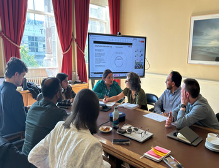Originally posted on the University of Cambridge’s Judge Business School website (2019).
A study co-authored by INDEX’s Stavros Polykarpou and Michael Barrett of Cambridge Judge Business School focuses on the ongoing and potentially fickle relationship between hospital IT investment and the hospital’s reputation. Owing to institutional pressures including funding and organisational constraints, healthcare practitioners have historically faced big pressures in justifying investment in health information technology (HIT) – as research has shown that the payoff of such investment is neither certain nor short-term. Most research in this area has focused on justifying the value of one-off investments after the investments have been made, based on financial or operational metrics. A new study co-authored by Dr Stavros Polykarpou and Professor Michael Barrett of Cambridge Judge Business School takes a different approach. Rather than looking at the effect of a one-time investment, the study instead focuses on how reputational value is addressed through an ongoing process of justifying HIT investments. The research looks at “value mutability” through a comparison of HIT at two hospital organisations in the English National Health Service – one a hospital that sought to restore damaged reputation following a regulatory inspection failure, and the other a hospital with a leading national and international reputation that sought to maintain such a reputation. The two hospitals studied are very different in scope and structure. Hospital 1 provides mental health and community services to more than 750,000 people across the UK, employing 2,500 people at 75 sites. Hospital 2, which provides specialist care to 3 million people, faced HIT expenditures as part of a site relocation and business transformation system that relied more on handheld devices and an electronic medical record system. The researchers contrasted them based on data collected over three years from site visits, formal and informal interviews and discussions, meeting observations, and public documents. The study just published in the journal Information and Organization develops a “process model” that looks at HIT practices and reputation, and this model can be applied to future situations by hospital managers and IT professionals. The study – entitled “Justifying health IT investments: a process model of framing practices and reputational value” – is co-authored by Dr Stavros Polykarpou of Cambridge Judge; Michael Barrett, Professor of Information Systems & Innovation Studies at Cambridge Judge; Eivor Oborn of Warwick Business School; Torsten Oliver Salge of Aachen University; David Antons of Aachen University; and Rajiv Kohli of the College of William and Mary. Professor Michael Barrett comments on some of the study’s findings and conclusions: We highlight how the justifying of HIT investments is an ongoing process which enacts reputational value that is nevertheless mutable over time. This has implications for how reputation is restored, enhanced, or maintained. Even though it is widely recognised that reputation takes significant time and effort to develop, reputational value is neither certain, nor a one-off outcome, as illustrated by our process model. The study’s process model takes a “bottom up” approach. This approach allows us to view HIT reputational value as ongoing and dynamic, something that unfolds continually over time through ongoing configuration. Previous studies had looked at financial or operational outcomes in isolation, but we instead look at value through HIT investments as an ongoing accomplishment – a value that may need to be maintained, restored or enhanced as the situation arises. Dr Stavros Polykarpou of Cambridge Judge comments on some of the study’s findings and conclusions: Hospital managers shouldn’t only focus on the most obvious stakeholders when it comes to IT. Regulators and funding commissioners may be highly strategic stakeholders, but patients, GPs and hospital staff are also crucial reputational stakeholders when it comes to framing an HIT approach. These managers need also beware of “reputation multiplicity” – put simply, a favourable reputation with clinical staff or commissioners may not ensure such a good reputation with regulators, and vice-versa. So we suggest that HIT investments be framed broadly to appeal widely. We suspect that reputation gained through HIT investment may prove fragile and tenuous. Stakeholders can change their perspective quickly and significantly, so what may appear enduring at one point of time cannot be taken for granted. Although we did not see value fragility in our two hospital cases, we welcome future research that looks at this issue in greater depth.




